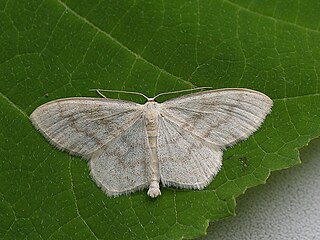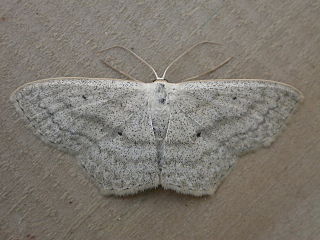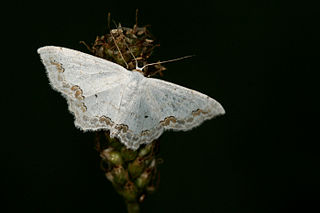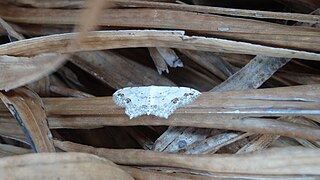
The cream wave is a moth of the family Geometridae. The species was first described by Adrian Hardy Haworth in 1809. It is found in forest and woodland regions, feeding on grasses and small plants such as dandelion.

Scopula decorata, the middle lace border, is a moth of the family Geometridae. It is found throughout Europe.

Scopula immorata, the Lewes wave, is a moth of the family Geometridae. It is found throughout Europe and the Near East.

Scopula nigropunctata, the sub-angled wave, is a moth of the family Geometridae. It is found through most of the Palearctic realm.

Scopula ornata, the lace border, is a moth of the family Geometridae. The species was first described by Giovanni Antonio Scopoli in his 1763 Entomologia Carniolica. It is found in Europe, North Africa and the Near East.

Scopula limboundata, the large lace-border, is a moth of the family Geometridae. It was described by Adrian Hardy Haworth in 1809. It is found in North America east of the Rocky Mountains. There is a single and unconfirmed record from Great Britain.

Scopula incanata is a species of moth in the family Geometridae. It is found from north-eastern Europe and the Caucasus to southern Siberia and northern Mongolia.
Scopula annularia is a moth of the family Geometridae first described by Charles Swinhoe in 1890. It is found from the north-eastern Himalayas to Hong Kong, Myanmar, Sumatra, Borneo, Java, the Philippines, Sulawesi and Seram.

Scopula subpunctaria is a species of moth in the family Geometridae. It is found from northern and north-eastern China to the southern Palearctic realm.
Scopula indicataria is a moth of the family Geometridae. It is found in China, Korea, Japan and Russia.

Scopula beckeraria is a moth of the family Geometridae. It was described by Julius Lederer in 1853. It is found in Italy, Croatia, North Macedonia, Greece, Bulgaria, Romania, Ukraine, Russia, Turkey, Armenia, Israel, Lebanon, Iran, Turkmenistan and Kazakhstan.

Scopula caesaria is a moth of the family Geometridae. It has a wide range, including the Comoros, Mayotte, La Réunion, Madagascar and in Mauritius, Nigeria, South Africa, Tanzania, Gambia, Oman, the United Arab Emirates, New Guinea, Taiwan, Japan and Australia (Queensland).
Scopula confinaria is a moth of the family Geometridae. It is found in southern Europe, southern Russia and Turkey.
Scopula impersonata is a moth of the family Geometridae. It is found in China, the Russian Far East, Taiwan and Japan.

Scopula luridata is a moth of the family Geometridae. It is found in southern Europe, Asia Minor, China, Pakistan, India, Egypt, Somalia, Yemen, Oman and Japan.

Scopula submutata, the Mediterranean lace border, is a moth of the family Geometridae. It is found in southern Europe, North Africa and the Near East. The habitat consists of open, dry grassland and rocky slopes.
Scopula pratana is a moth of the family Geometridae. It is found in North Africa, the Canary Islands, the Near East and Yemen.

Scopula pulchellata is a moth of the family Geometridae. It is found in the Indo-Australian tropics, from India, Sri Lanka to Taiwan and the Solomon Islands, as well as in Africa.

Scopula umbelaria is a moth of the family Geometridae described by Jacob Hübner in 1813. It is found in the Benelux, France, Italy, Germany, Switzerland, Austria, the Czech Republic, Slovakia, Hungary, Slovenia, former Yugoslavia, Romania, Poland and Russia. In the east, the range extends to the eastern part of the Palearctic realm.
Scopula sideraria is a moth of the family Geometridae. It is found in western North America, from southern British Columbia to San Diego County, California.













